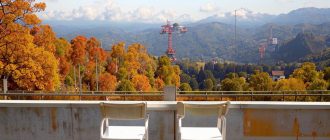Vladimir Vysotsky once said: «There can be better mountains than mountains.» And he was right. Mountains are one of the most attractive places on Earth. Just imagine how you rise above the clouds and you get a view of marvelous landscapes.
But is it so easy to conquer a mountain peak for a beginner? Yes, if you prepare properly.

is an experienced traveler, participant of mountain treks in Baikal and Altai.
She shared her experience of mountain climbing with us.
How to prepare for the first mountain hike?
Let’s start with the fact that there are a lot of options to get to the mountains. Among them, for example, there is mountaineering and mountain tourism. It is about mountain tourism that we will talk about. These sports are very similar to each other, but still the goal of mountaineers — to climb to the top, and the task of mountain tourists — to overcome the route on the mountain terrain.

For those who have not tried either of them, hiking is an ideal option. But you must realize that hiking, especially in the mountains, is an extreme sport. Any climbing requires deep thought and a lot of preparation, so going just for the sake of company is very silly.
Here is what you will need for your first hike in the mountains.
Physical preparedness
Without physical fitness and experience, such an undertaking can knock you out of the running. There are six categories of complexity of hiking, and you need to start, of course, with the simplest.

In the first category, the length of the route is about 100 km. I, for example, overcame my first route in a week. For me it was actually a training before a more difficult hike, a mountain tour on Baikal — my first ascent, which lasted almost the whole day. It is also a mountain hike of the first category of difficulty — it does not imply difficult crossings, steep ascents and descents.
But for those who go to the mountains for the first time, it will still be difficult to pass it. In our group, for example, many people were quite hysterical and wanted to turn back. Because the long long ascent with a backpack weighing 20 kilograms was very unbalancing. In addition, the mountains met us with a strong thunderstorm and we all got wet.
However, in a couple of days everyone came back to normal — so to speak, we overcame fire, water and copper pipes. After all, day after day, the body trains and gets used to the physical load. So if you endure the hike of the first category of difficulty, you can go further.

Mountains are addictive, so the next year I went to Altai — after all, it is the dream of almost every person in Russia. This hike was already more difficult — it is large in kilometers and involves a long route of about two weeks. You need to be ready for the fact that you will have to pass glaciers, difficult steep descents and kurumniks — piles of stones of different sizes.
Here I climbed to the height of 2700 meters for the first time, and some people went higher. In fact, the whole route we were jumping around the mountain like goats with ski poles in our hands and backpacks on our backs. But it was worth it — the hike was great.

Absence of chronic diseases and good health condition
As for the requirements, good physical health, strong immunity and absence of chronic diseases are very important. Otherwise, all of this will affect everyone in the group. Because from point A to point B, everyone must get there safe and sound, and most importantly — on time.
No one goes back, everyone follows the established route. Any problems, injuries or illnesses can cause the whole group to slow down. This will cause the route to be changed, and therefore those who are in the group will be upset. In addition, you will reach the end point at the wrong time, which means that the Ministry of Emergency Situations will start looking for you — after all, hiking groups register their hikes.

Skills and a positive attitude
To keep up with the group and see more beauties, it is important to have at least basic hiking skills and a positive attitude. Of course, the instructor is responsible for the hikers, but you have to help out too. Here are the skills that will come in handy:
- self-care skills;
- communication skills, the ability to be helpful and supportive;
- positive and cheerful mood;
- knowledge of nature and what can be used on the way;
- skills of making a fire, setting up a tent;
- experience with equipment.

What is the initial route?
The hike of the first category of complexity assumes rest every hour for 15-20 minutes. For example, if the length of the route is three kilometers, it does not mean that from the morning you are obliged to pass this route. No, the altitude gain can be 100, 200 or 300 meters.
But even 100 meters of climbing in the mountains when the slope is steep is not easy. And when there are stones under your feet, you have to choose another, longer route, which is even more difficult. Especially when you have a heavy rucksack on your back.
If the slope is gentle, of course, you can walk more. But if it is very steep, even a short distance will take a long time. For example, in the morning you got up, had breakfast, climbed, let’s say, 500 meters, then climbed to the pass and rested. Then we descended slowly as well, because it is physically impossible and dangerous to ascend and descend quickly.
Sometimes you have to move by ropes. And sometimes it happens that someone’s feet are above your head and your feet are above someone else’s — that’s why you step very carefully, catching stones carefully so that they don’t fall down and provoke a rockfall.
What precautions are there?

Mountains have their own laws and rules. Climbing is dangerous and some people die. On each of the routes I have traveled, where there were some difficult passes, there were signs saying that a person had died. Considering that much of the mountains are covered with glaciers and there is very poor communication, it is very important to take precautions:
- when climbing on a glacier, the handling of mountaineering crampons — special mounts on boots for traveling on ice terrain — must be absolutely correct;
- you must not touch the ice with your hands and knees, because otherwise you will roll down and the slide will cost you your life;
- you must not fall on the glacier, because it will definitely lead to death;
- any ascent requires mandatory knowledge of the route. The instructor should know everything «from and up to» — where there may be slopes, kurumniks, in what places there are especially dangerous zones and fords, how to cross rivers better, especially after rain;
- you need to know where bivouacs are located — equipped places where you can rest or spend the night;
- in case of an emergency, you should know how to contact the Ministry of Emergency Situations as soon as possible;
- and most importantly, it is necessary to register your trip with the rescuers. Some hikers do not do this, get lost and die.

What to take with you?
The list of necessary things depends on the complexity and duration of the route, but here is what is approximately included there:
- replacement and thermal underwear;
- special mountain shoes;
- raincoats, windbreakers, warm jacket — in general, everything that dries quickly, does not blow away and keeps warm. All this is sold in specialized stores;
- headgear and sunscreen — when climbing the glaciers you will burn instantly. Where the snow is already above 3.5 kilometers, the sun is blinding;
- mosquito and tick repellent — if you are in a valley or walking in a forest area, protection from ticks is a must;
- tourist equipment is taken by the instructor himself.

What about meals?
Meals are thought out by the instructor, and he also makes a list of products, takes into account all the economic costs. Most often, the participants are given an hour and a half to have a snack, no more than that — they have to meet this time limit.
During the hike, everything is strictly on schedule, even if the weather conditions are unfavorable. The main thing is to quickly boil, eat, clean up after themselves, rest a little and go on. After all, if you walk less than the conditionally planned 10 km, the next day you will have to walk even more.
After all, this is a sport hike, and there can be no relaxation here. Unless, of course, it is an easy event, where you walk a little and sit a lot.






